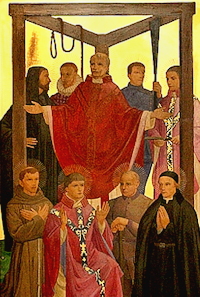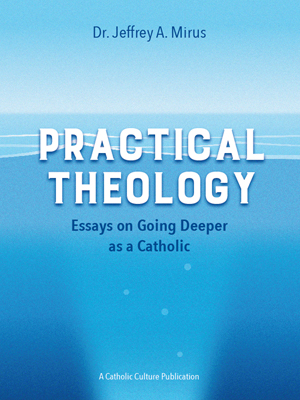Ordinary Time: October 25th
Tuesday of the Thirtieth Week of Ordinary Time; Forty Martyrs of England & Wales (Eng & Wal)
Other Commemorations: Six Welsh Martyrs and Companions (Wales); Sts. Chrysanthus and Daria, Martyrs (RM); Sts. Crispin and Crispinian, Martyrs (RM)
» Enjoy our Liturgical Seasons series of e-books!
Today in England is the feast of the Forty Holy Martyrs of England and Wales (in Wales this is a memorial), a group of forty men, women, religious, priests, and lay people who were canonized by Pope Paul VI on October 25, 1970. These people were executed for their Faith during a period of anti-Catholicism from 1535 to 1679. The Martyrs who were canonized were among more than two hundred martyrs who had been beatified by various earlier popes.
Some of the common "crimes" of these people were being priests, harboring priests, or refusing to take the Oath of Supremacy. This group of saints includes some well-known saints, such as St. Alban Roe, and St. Edmund Campion. Many of these saints are recognized on the days of their martyrdom, but as a group, they are recognized on the day they were canonized. — Al Bushra
According to the 1962 Missal of St. John XXIII the Extraordinary Form of the Roman Rite, today is the feast of Sts. Chrysanthus and Daria, a husband and wife who carried on an active apostolate among the noble families of Rome during the third century. When they were denounced as Christians, they underwent various tortures with great constancy, and they were buried alive in a sandpit in the year 283.
Today the Roman Martyrology remembers the martyrs Crispin and Crispinian, who died in the persecution of Diocletian by the sword. They were brothers, possibly twins, and cobblers. St. Crispin's day has been immortalized by Shakespeare's Henry V speech before the Battle of Agincourt in 1415.
Six Welsh Martyrs and Companions
The Forty Martyrs of England and Wales were selected from among the hundreds of Catholics who gave their lives for the faith during the dark days of persecution of Catholics in England. The Forty were canonized by Pope St. Paul VI on October 25, 1970. Six of the Forty were Welsh and celebrate this day as a feast in Wales. These six comprised of a married man, a Franciscan, a Benedictine, two Jesuits and a diocesan priest. The rest of the forty were English martyrs and celebrated on May 4 (listed here).
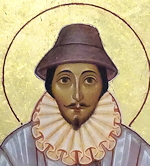 |
St. Richard Gwyn was born about 1537 in Llanidloes, Montgomeryshire. He was a teacher and a married man. He and his wife, Catherine, had six children. He was executed at Wrexham on October 15, 1584. St Richard Gwyn is the Protomartyr of Wales. |
 |
St. John Jones, OFM was born at Clynog Fawr, Caernarvonshire around the year 1530. He entered the Franciscan Convent at Greenwich and, at its dissolution in 1559, he went to the Continent and was professed at Pontoise, France. He died for the Faith at Southwark on July 12, 1598. At his execution, he had to wait an hour because the hangman had forgotten to bring the rope! |
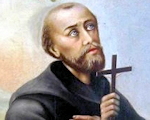 |
St. John Roberts, OSB, born at Trawsfynydd, Merionethshire, was the first prior of St Gregory’s, Douai. He was sent upon the English Mission in December 1602, arriving in England in April 1603. He was probably the first monastic to enter England since the Reformation. He was executed at Tyburn on December 10, 1610. |
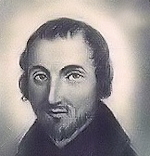 |
St. Philip Evans, SJ was born in Monmouth in 1645. He entered the Society of Jesus on September 7, 1665. He was ordained at Liege and sent upon the English Mission in 1675. He diligently and joyfully served the area of South Wales for four years before his arrest at the house of Christopher Turberville at Sker, Glamorganshire on 4th December 1678. He was martyred at Cardiff on July 22, 1679. He was thirty-four years old. |
 |
St. John Lloyd was Brecon born and studied at Ghent and Valladolid. He was ordained a priest at Valladolid in 1653. He returned to Wales and labored in Brecon and Monmouthshire for 24 years. In November of 1678, he was captured at a house at Penllyn, Glamorganshire. He and St Philip Evans shared a cell at Cardiff Castle until their martyrdom at Cardiff on July 22, 1679. |
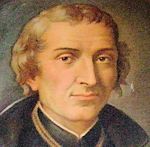 |
St. David Lewis was born in 1616 at Abergavenny, Monmouthshire. He attended the local Grammar school where his father, Morgan Lewis, was headmaster. Ordained in 1642, David entered the Jesuit novitiate in 1645. He returned to Wales and, based at the Cwm, he served the Catholics of the area for 34 years. He was arrested at Llantarnam on 17th November 1678 and martyred at Usk on August 27, 1679. St David Lewis was the last Welsh martyr. |
—Excerpted from Last Welsh Martyr
Highlights and Things to Do:
- If you would like to learn more about the Forty Martyrs you can purchase a pamphlet published by the Catholic Truth Society, A Book of Martyrs by Fr John S. Hogan.
- For a list of the forty martyrs and a little more information about some of them, you can visit this site.
- Read more about the martyrs:
Sts. Chrysanthus and Daria
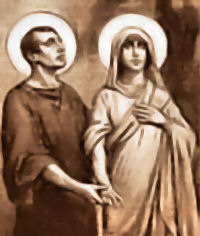 According to legend these two saints belonged to the nobility. Daria received baptism through the efforts of her husband Chrysanthus. In Rome, they were instrumental in bringing many to the faith, for which cause they were cruelly martyred. Chrysanthus was sewn inside an ox's hide and placed where the sun shone hottest. Taken to a house of ill-fame, Daria was protected by a lion while she passed the time in prayer. Finally, both were buried alive in a sand-pit and thereby together gained the crown of martyrdom (283). They were buried in the Jordan cemetery on the Via Saleria, Rome; at the same site were buried sixty-two soldiers who died as martyrs and also a group of faithful who had gathered together for the holy Sacrifice on the anniversary of saints' deaths but were cut down by the enemies of Christ.
According to legend these two saints belonged to the nobility. Daria received baptism through the efforts of her husband Chrysanthus. In Rome, they were instrumental in bringing many to the faith, for which cause they were cruelly martyred. Chrysanthus was sewn inside an ox's hide and placed where the sun shone hottest. Taken to a house of ill-fame, Daria was protected by a lion while she passed the time in prayer. Finally, both were buried alive in a sand-pit and thereby together gained the crown of martyrdom (283). They were buried in the Jordan cemetery on the Via Saleria, Rome; at the same site were buried sixty-two soldiers who died as martyrs and also a group of faithful who had gathered together for the holy Sacrifice on the anniversary of saints' deaths but were cut down by the enemies of Christ.
—Excerpted from The Church's Year of Grace, Pius Parsch
Patronage: Eissel, Germany; Salzburg, Austria.
Symbols and Representation: Ox skin; sandpit.
Highlights andThings To Do:
- Read more about these martyrs:
Sts. Crispin and Crispinian
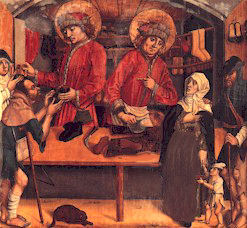 The Roman Martyrology includes these twin brother martyrs for this day. St. Crispin was a Roman noble and brother of Saint Crispinian with whom he evangelized Gaul in the middle 3rd century. They worked from Soissons, preached in the streets by day and made shoes by night. The group's charity, piety and contempt of material things impressed the locals, and many converted in the years of their ministry. They were martyred in Rome in 286 by torture and beheading, under emperor Maximian Herculeus, being tried by Rictus Varus, governor of Belgic Gaul and an enemy of Christianity. A great church was built at Soissons in the 6th century in their honor; Saint Eligius ornamented their shrine.
The Roman Martyrology includes these twin brother martyrs for this day. St. Crispin was a Roman noble and brother of Saint Crispinian with whom he evangelized Gaul in the middle 3rd century. They worked from Soissons, preached in the streets by day and made shoes by night. The group's charity, piety and contempt of material things impressed the locals, and many converted in the years of their ministry. They were martyred in Rome in 286 by torture and beheading, under emperor Maximian Herculeus, being tried by Rictus Varus, governor of Belgic Gaul and an enemy of Christianity. A great church was built at Soissons in the 6th century in their honor; Saint Eligius ornamented their shrine.
This feast was immortalized by Shakespeare in his play Henry V, (Act 4, Scene 3). The king gave a rousing speech (called "Saint Crispin's Day) on the eve of the Battle of Agincourt, fought on this day in 1415. (Read a synopsis of the battle.) The English, although outnumbered, soundly defeated the French. In England this was a religious holiday on which commoners and serfs got a day of rest.
Patronage: Cobblers; glove makers; lace makers; lace workers; leather workers; saddle makers; tanners; weavers.
Symbols and Representation: Cobbler's last; shoe; shoemaker's tools; awl and knife saltire; millstones; flaying knives; rack.
Highlights and Things To Do:
- Read more about Sts. Crispin and Crispinian:
- See St. Crispin's Day for Catechists.
- Shakespeare's Henry V speech on St. Crispin's Day: Read the text and watch the excerpt.
- Because of the name "Crisp" and their work as cobblers, a fruit crisp or cobbler is perfect to make on this feast day, particularly apples since it's close to their harvest time. Try some of the recipes of Catholic Culture, or Catholic Cuisine.





